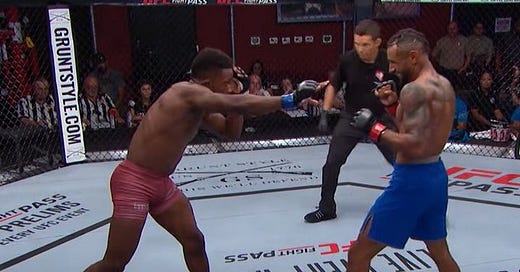Intro to the Lead Foot Position
A notable position that Yusuff takes in his fights is where he has his weight over his lead foot and his rear hand extended controlling the opponent’s jabbing line.
Here are the features of the position:
This is a position that Jack Slack has also examined in detail in his Advanced Striking 2.0 Israel Adesanya.
“The crux of this double threat is that Adesanya is fighting from a squared position. He has coiled up a powerful jab but lengthened the motion of the jab as a trade-off. And he has shortened and sped up the path of the low kick, at the expense of some power. This shaving down the length of strikes brings us onto a crucial element of Adesanya’s striking success: feinting.”
-Jack Slack from Advanced Striking 2.0
Here is Trevor Whittman demonstrating the lead foot position out of an orthodox stance. This position gives power to the lead hand while the rear hand controls the opponent’s lead hand in a closed stance match up. In short, lead sided strikes gain power, rear sided strikes are for speed and gauging reactions.
The lead foot position is a position a fighter takes while they are “on the tracks” with their opponent. This position occurs in every fight, and it is a position where both fighters are in range to be hit.
Figure above explains what it means to be on the tracks.
Range Options off the Lead Foot Position
There are two main options that Yusuff uses from this position
The calf kick
The jab
Calf kick
If the opponent steps forward to attack his position, Yusuff will use the calf kick. With his hips square he has shortened the path of the calf kick.
What’s important here is the timing where Yusuff hits his opponent’s calf just as they put weight onto the lead foot.
Notice how Yusuff times his low kick as Davis tries to punch his way in “on the tracks”.
Yusuff has also shown that he will throw the low kick naked if his opponent transitions his weight off the lead foot. The key to this is timing and recognition. For Yusuff to execute this properly he has to start his low kick as soon as the opponent has transitioned their weight to the lead foot, Yusuff can hit the calf just as the opponent’s weight comes off the lead foot.
Only the foot lands in this sequence, but its the timing of the opponents weight coming of the lead foot that debases Davis.
Jab
If the opponent moves backwards and decides not to engage, Yusuff can jab. And because he has squared up his stance he has lengthened the path of his jab.
The lengthened jab allows Yusuff to catch the opponent tall and off balanced, this is especially powerful if Yusuff times his jab right when the opponent is transitioning their weight from lead foot for rear foot.
Source: Secrets to Counter Fighting by Trevor Whittman
Yoza Kick
A really nice addition to the lead foot position by Yusuff is the Yoza kick when the opponent stands still. Yusuff will control the jabbing line and if the opponent does nothing he can use his rear leg front kick to the opponent’s rear leg.
Yuki Yoza, the kick for which this technique is named for , normally backs his opponent up near the boundary to remove their retreat before throwing this kick.
By adding this kick to his lead foot position, Yusuff is able to use the Yoza kick in the middle of the cage. In the fight with Barboza specifically, Yusuff prevented Barboza from using his switch kick. This was an interesting application of the Yoza kick since Yusuff executed it as a long range weapon then kick used after a combination.
Conclusion
This study shows just three options Yusuff has from this position. He clearly has more options, but that is an article for another day.
Paid Members
full access to my scouting reports and execution series as well as all my short videos with annotations.
full access to all my post fight studies
early looks at things I am working on
Make sure you follow me at all my socials:
I only say obnoxious things on twitter, everywhere else I try to post good content.







Ghost don’t miss ! Love it